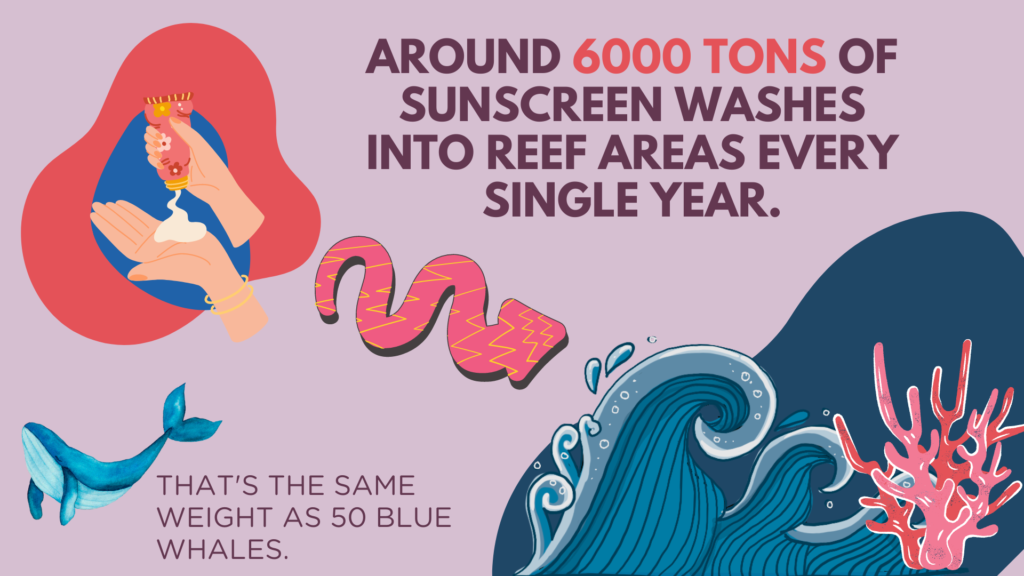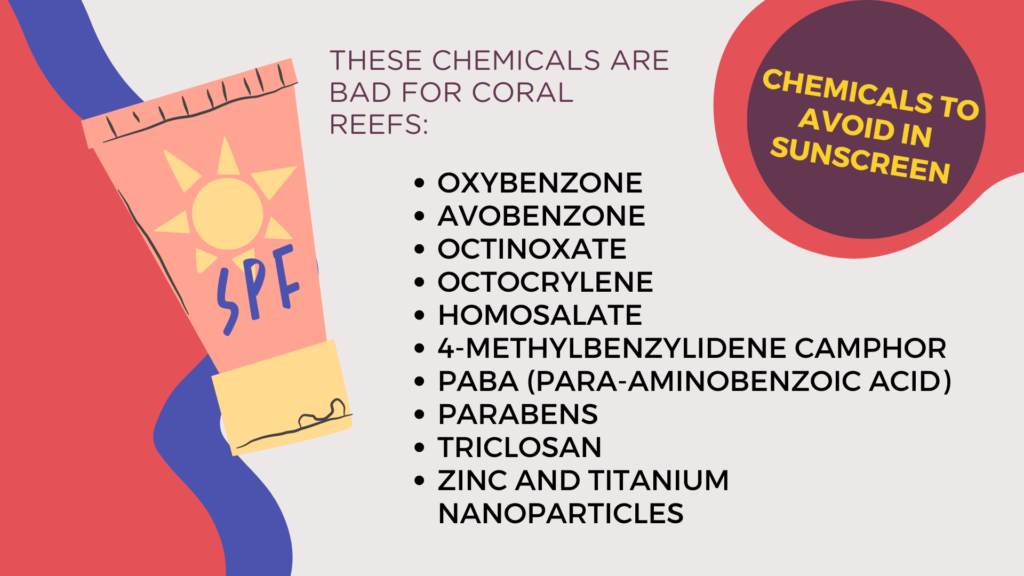
Did you know that the sunscreen you apply doesn’t always stay on your skin? In fact, when we swim (or even shower), the sunscreen you’ve applied throughout the day washes off into waterways and often ends up in the ocean. In fact, around 6000 tons of sunscreen washes off into reef areas every year, according to scientists. That’s equal to the weight of nearly 50 blue whales!
While we depend on sunscreen to protect us from skin damage and disease, many sunscreens actually cause great harm to marine ecosystems. And with 80% of corals in the Caribbean lost in the last 50 years, in part due to pollution, it’s more important now than ever before to ensure we take steps to avoid damaging these important organisms further.
But how exactly does sunscreen damage coral reefs, and what can we do about it? Let’s dive in.
Protection for People, Harm to Marine Life
Researchers estimate that approximately 10%, if not more, of coral reefs around the world are threatened by sunscreen. The areas feeling the brunt of the damage are highly-tourested areas like Hawaii and the Caribbean, where thousands of tourists swim every day, leaving sunscreen behind them.
So, how is sunscreen killing coral reefs? There are two main types of sunscreen: physical and chemical. Unfortunately, both types of sunscreen can cause harm to coral and other types of marine life.
Physical sunscreen is made of minerals that sit on top of your skin and reflect the sun’s rays. The main minerals used for this purpose are titanium dioxide and zinc oxide, which can wash off into the water. In fact, studies estimate that the average tourists on a Mediterranean beach release 4kg of titanium dioxide in a single day. When these minerals are very small (called “nanoparticles”), they can be absorbed by coral and cause severe damage.
A 2018 study found that zinc oxide nanoparticles cause extreme coral bleaching. This is because the zinc interferes with symbiosis between coral and other organisms, which leads to bleaching over time. Zinc oxide and titanium dioxide nanoparticles in the ocean may also cause chemical reactions to occur that result in hydrogen peroxide, which bleaches coral.
Chemical sunscreens contain chemicals that absorb into the skin, and then absorb UV rays before they can hit your skin. The active ingredients include “UV filtering” chemicals avobenzone, octinoxate, and oxybenzone. These are extremely potent and toxic to marine animals including coral.
New Research: How Does Sunscreen Harm Coral Reefs?
While scientists have known that oxybenzone damages coral reefs for a while, they did not know exactly how the chemical was causing harm. In May 2022, researchers at Stanford released a study that explored oxybenzone’s effects on sea anemone, an organism that’s closely related to corals.
The researchers found that when oxybenzone was exposed to light and a sugar found in anemone tissue, not only did it kill the anemone, but the chemical metabolized into another molecule, releasing free radicals that kill coral. Sea anemones exposed to oxybenzone and sunlight died around one-three weeks after exposure.
Finally, preservatives used in sunscreen to help the product last longer can also have toxic effects on both humans and coral. For example, parabens, a class of preservatives, are used in many sunscreens to prevent the growth of bacteria and mold. However, parabens can wash off into the environment, and have been found in a wide variety of organisms all over the world, from fish to marine mammals and birds. Studies show that parabens can disrupt the hormones of a variety of animals, including humans.
Parabens can also cause viral infections in zooxanthellae, symbiotic algae that live in healthy coral tissue and provide it with nutrients. A 2008 study showed that, because of these viral infections, coral bleaching occurred within a few hours to a few days of exposure to even very small amounts of sunscreen.
Does Sunscreen Harm Other Types of Ecosystems?
It’s not just marine life that’s impacted by sunscreen. When we shower, sunscreen is often washed off into wastewater, which makes its way into fresh bodies of water. However, due to the extreme variety of aquatic ecosystems throughout the world, the specific impacts of sunscreen in aquatic environments are still unknown.
Many experts are calling for more research into the impacts of sunscreen on non-marine ecosystems. In August 2022, the National Academies of Sciences, Engineering and Medicine published a report calling on the US EPA to conduct further studies into the risks that UV filters cause to aquatic ecosystems (including freshwater). They explain that while we know UV filters have been found in water, sediment and even animal tissue in a variety of ecosystems, we need more information to understand the extent of the impacts they’re having on a variety of aquatic organisms.
Government attention to the issue of sunscreen killing coral reefs is not limited to scientific data gathering, however. Next, we’ll review how a few governments have taken a stab at protecting coral reefs and other marine organisms from toxic sunscreen ingredients.
Legislation: Bans on Reef-Toxic Sunscreen
In response to concerns about the toxic effects of sunscreen on coral reefs and the intense reduction in living coral reefs, several governments have passed legislation banning sunscreen containing oxybenzone and octinoxate.
Hawaii was the first state to ban harmful sunscreens with the passage of a bill in 2018 that banned oxybenzone and octinoxate sunscreens. In 2021, the Hawaii State Legislature passed another bill that banned two more harmful chemicals in sunscreen, avobenzone and octocrylene.
Other local and federal governments have also banned harmful sunscreens, including:
What You Can Do to Protect the Ocean from Harmful Sunscreen
There are a few things you can do to avoid putting more harmful sunscreen into the ocean.
1. Use other forms of sun protection. While sunscreen is, of course, a necessary product to protect ourselves from harmful ultraviolet rays, it should really be a last resort. Instead, use UV-protective clothing like a sun shirt to reduce the amount of sun your skin is exposed to. You can also try and spend time in the shade to protect your skin.
2. Use reef-safe sunscreen. When you do need to use sunscreen, make sure it’s a reef-safe sunscreen. First, avoid spray-on (aerosol) sunscreen, as the spray disperses into the environment much more easily than a cream, and often contains harmful chemicals. Instead, opt for a mineral sunscreen with zinc oxide and titanium dioxide that aren’t nanoparticles (if the packaging doesn’t explicitly say “micro-sized” or “non-nano,” you can be pretty sure it contains harmful nano-sized particles).
To figure out if a sunscreen is truly reef friendly, look at the label. Make sure to avoid these chemicals:

Finally, while sunscreen in the ocean is clearly harming coral reefs, we must also take into consideration the other threats to coral reefs, including overfishing and climate change’s rising temperatures. Changing to a reef-safe sunscreen may make a small dent, but we must curb climate change in order to truly protect coral reefs and other marine life.